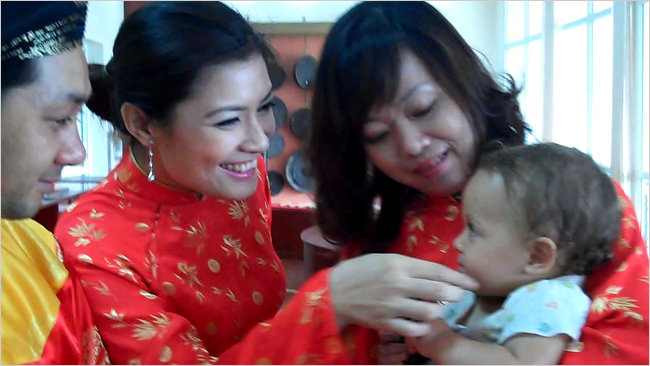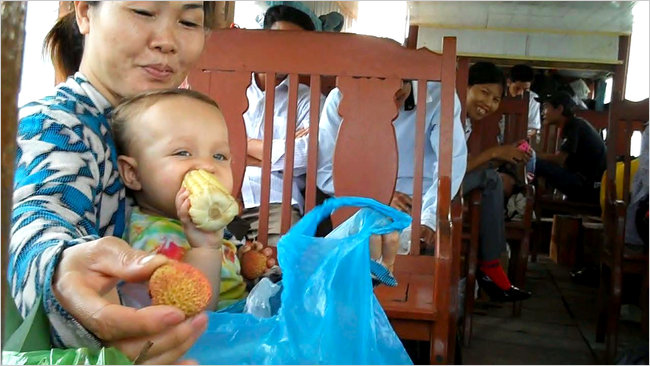At our hotel, she was instantly scooped up by a grinning receptionist who carried her outside and paraded her up and down the street, introducing her to everyone who lived along that narrow alleyway. In a teeming market in the old Chinese district of Cholon, a small mob flocked around us, hands outstretched to hold her.
We began to feel like the minders of a wildly popular celebrity who patiently complied with the whims of her fans, even if she seemed a little perplexed about how she’d suddenly become so famous.
On a bus in Vietnam
My husband and I had arrived in Southeast Asia with our 10-month-old daughter, Yael, on the advice of friends with older children who warned us that travel would only get harder in the years ahead. They described the time between the fragility of early infancy and the havoc of mobile toddlerhood — roughly, between months 6 and 12 — as a golden opportunity for taking a baby just about anywhere.
“Go while she’s still portable!” they implored us. “She’s just a sack of potatoes now, like an extra piece of luggage.”
Her four nervous grandparents wondered why this extra piece of luggage couldn’t stay at home with them; they were certain that Yael would end up for sale on the international black market. Even I, normally low on the scale of motherly neuroses, struggled to tamp down my fears as our day of departure approached. Nevertheless, my husband and I set out with hopes of approximating the kind of travel we had in our prebaby lives, with little clue of how profoundly different it is to wander the world with a little one on your back.
Ho Chi Minh City was only the beginning. On a packed bus lumbering through the Mekong River delta, Yael was passed from rider to rider, each one planting kisses on her cheek and pinching her chubby thighs. On the beach in Danang, tough, tattooed young men leapt toward her like gazelles, tenderly cradling her and smelling her neck as if it was the first flowering peach blossom of spring. Military officers in medal-adorned uniforms, teenagers with jagged boy-band haircuts, young women peddling pineapples, old women with teeth stained black from years of chewing betel nut — people of every age and background wanted a chance to cuddle and coo over our daughter. We came to realize that this wasn’t because of the novelty of her straw-colored hair and steel blue eyes, but because she was a baby in a corner of the world where people are obsessed with babies and seem to regard them as communal property.
 In Hanoi
In HanoiThe American school of overcautious parenting, I was sure, would have none of this. Shouldn’t we have been suspicious of strangers, paranoid about germs and fretful about her safety? Instead, we were schlepping our beloved child to places like Muong Noi, a tiny village in northern Laos that’s accessible only by boat, where we stifled our worries that she might pick up giardia from a dip in the river, tried to keep monosodium glutamate out of her boiled vegetables, fanned her constantly in withering 90-degree heat and entertained her with a ragtag assortment of plastic straws, business cards and chopsticks. (There was no room for her real toys in our backpacks.)
But any pangs of anxiety were far outweighed by the realization that, actually, Yael was just fine. More than fine. She became delightfully addicted to every tropical fruit she got her little hands on: rambutan, sapote, mangosteen and, above all, litchi. She saw animals every day — cows, chickens, pigs, frogs, turtles and goats — that had previously only existed as abstractions on her urban bookshelf. She was spoken to in half a dozen languages and was showered from dawn to dusk with the kind of fawning love and attention that, in the United States, only comes from family members. She was also practicing her crawling skills, albeit on the stone slabs of
Angkor Wat.
As for my husband and me, we soon learned what many who have journeyed abroad with a baby know well: small children are the ultimate traveling prop, a cultural bridge nonpareil. Instead of wafting through the background of other people’s exotic lives, we became a spectacle ourselves. We were introduced to seemingly every infant living between the Mekong River and the South China Sea. Using hand gestures and basic English, we traded milestone stats with their parents — How old? Walking yet? How many teeth? Sleeping through the night?
At the same time, we absorbed parenting differences as if we were conducting an independent study in pediatric anthropology. In Kep, a seaside town in southern Cambodia, we were told that babies’ foreheads should be marked with ash when they leave the house as a measure of protection. In the Laotian village of Nong Khiaw, we were reassured that because our daughter was born in the Year of the Ox, she would become a hard worker and a good wife. In the Vietnamese mountain town of Bac Ha, we were surrounded by Hmong women who said that shamans advise changing newborns’ names if they cry excessively, and they were perplexed when I explained that American mothers typically don’t go to work with their babies strapped to their backs. (They gasped when I told them the going pay rate for New York nannies.)
But the biggest difference between us and those we met had nothing to do with rituals, astrology or superstition. It had to do with motorbikes, which growl along Southeast Asian roads by the million and have become as emblematic of the region as terraced rice paddies and lemon grass. It’s not uncommon to see families of four or five, including children and babies, perched on a single motorbike — without helmets, no less.
Helmetless babies on motorbikes! At home, this could be justification for a child’s removal by state protective services. More than once, when an old woman admonished us for taking our daughter outside in the midday heat, we retorted that at least we weren’t speeding her through knots of traffic in
Hanoi on a Honda Metropolitan. Our point simply didn’t compute.
Near the end of our two-month journey, we boarded a small ferry to Quan Lan Island, a sliver of land in Bai Tu Long Bay, east of Hanoi. A squat, rectangular boat with frilly curtains framing the cabin’s windows, its four-hour chug across the bay was so slow and rhythmic as to induce a trance. As we’d become accustomed, Yael was coaxed from our arms by other passengers, and my husband and I both stretched out on wooden benches and dozed.
 On a boat in Bai Tu Long Bay, Vietnam
On a boat in Bai Tu Long Bay, VietnamEvery so often, we cracked open our eyes and saw women feeding her peeled litchis and boiled corn, or holding her up to the window to see the sunset’s glow over the crystalline blue water. At one point, we spied her in the arms of the captain, her hand on the wheel of the boat, giggling and gaping at the horizon as we made our way across the sea.
Source: http://travel.nytimes.com/2010/12/19/travel/19journeys-babies.html